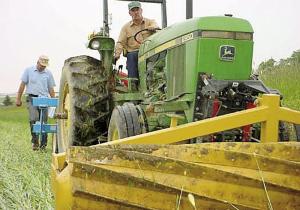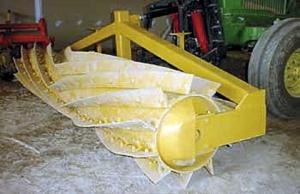2004 - Volume #28, Issue #3, Page #26
[ Sample Stories From This Issue | List of All Stories In This Issue | Print this story
| Read this issue]
Cover Crop Roller Helps Organic No-Till Work
 |
 |
"We've been working on systems for using cover crops in organic production for about 15 years," says Jeff Moyer, farm manager, Rodale Institute. "We believe the cover crop is the most important crop on the farm. If it does well, nitrogen management and weed control do well."
Cover crops build fertility and control winter annuals and other out-of-season weeds. Unfortunately, cover crops must either be sprayed with herbicides or plowed under.
Moyer reports that people have tried different systems, such as the Buffalo Stalk Chopper, to crush cover crops. Some don't work without herbicides, while others are too aggressive and expose soil for weed seeds to germinate. Pull-behinds often don't affect plant material in wheel tracks. Rollers with straight blades across the cylinder tend to bounce, leaving cover crop plants unaffected.
Even if a cover crop was successfully rolled, planting into it was difficult at best. Row markers didn't work in the heavy mulch, and planting had to be in the same direction the roller went.
Moyer decided they needed a device that was front-mounted and sized to match 4-row equipment.
He and John Brubaker, a neighbor experienced in metal work, designed and built a roller that appears to meet Moyer's goals. The single 10-ft. 6-in. long, 16-in. diameter cylinder requires only two bearings and can be filled with water for added weight as desired. Cutting blades are mounted at an angle, bending toward the center from either end. Blades are attached to the cylinder at less than a 90_ angle.
"Twisting the blades toward the center eliminates the cylinder bouncing as it would if they were straight across," explains Moyer. "If they were twisted in just one direction like a screw, it would pull the tractor in that direction. By twisting into the center from both sides, it eliminates that pull."
Brubaker suggested setting the blades at an angle to the cylinder after noticing how cleats mounted at 90_ on a steel wheel will kick up soil. "If they are at an angle, they lift out of the soil without tearing up it or the cover crop," notes Moyer.
The first step was to pre-bend the 1/2-in. thick, 4-in. rolled steel blades to achieve the less than 90_ angle. Then they laid a string along the cylinder to get the arc or twist they wanted. Each arc was approximately 14 in. from the previous arc.
The next step was to weld 1 1/2-in. pieces of angle iron to the cylinder every 8 in. along the desired arcs.
"We secured each blade at one end of the cylinder and then used a pipe wrench to yank the other end to where it could be secured," says Moyer. "We then went along and drilled holes in the blade to line up with the angle irons."
Square holes were punched through the plates to allow the use of carriage head bolts. In plot tests this past season, the unit worked perfectly, reports Moyer.
Moyer and his team are planning to do more extensive fieldwork this spring. They will be working with a 2-row vacuum planter with double-disc openers modified to four 30-in. rows. He also hopes to use it with a grain drill for narrow row soybeans.
Contact: FARM SHOW Followup, Jeff Moyer, The Rodale Institute, 611 Siegfriedale Rd., Kutztown, Pa. 19530 (ph 610 683-1420; email: jeff.moyer@rodaleim.fp.org; website: www.newfarm.org).

Click here to download page story appeared in.

Click here to read entire issue
To read the rest of this story, download this issue below or click here to register with your account number.




